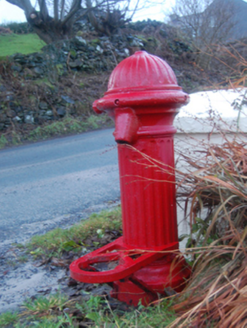Survey Data
Reg No
40831004
Rating
Regional
Categories of Special Interest
Social, Technical
Original Use
Water pump
Date
1900 - 1940
Coordinates
170989, 399050
Date Recorded
14/01/2011
Date Updated
--/--/--
Description
Freestanding cast-iron water hydrant, erected c. 1920, comprising fluted shaft on moulded base, moulded spout, cast-iron pail\bucket stand to base, and surmounted by fluted domed capping (acorn finial over now missing). Pull lever to side. Foundry mark to base now obscured. Located adjacent to smooth rendered boundary wall of two-storey house close to the junction of two roads. Sited grounds in the rural countryside to the north-west of Ardara, close to Gweebara Bay\Tramore Strand adjacent to the north.
Appraisal
An attractive piece of mass-produced cast-iron, which is an appealing and subtle feature in the rural landscape close to the scenic coastline overlooking Gweebara Bay\Tramore Strand adjacent to the north. This particular example is notable due to its excellent preservation, and retains a rare surviving example of a pail\bucket stand. This water hydrant is of particular importance as a reminder of the mechanisms installed for the supply of clean drinking water in the period before mains water supply systems. The various fluted and moulded details enhances the artistic design quality of the piece, and indicates the equal importance of aesthetics as well as functionality. Although the foundry mark to the front is now obscured, the style of this water hydrant suggests that it was made at the Glenfield and Kennedy Ltd. Foundry in Scotland, which was the major company producing and selling cast-iron water mechanisms within the British Empire during the late-nineteenth and early-twentieth century. This simple item of street furniture makes a positive contribution to the local environment, and is an addition to the built heritage and social history of the local area. It is located adjacent to a rural road junction, a common site for such artefacts.

